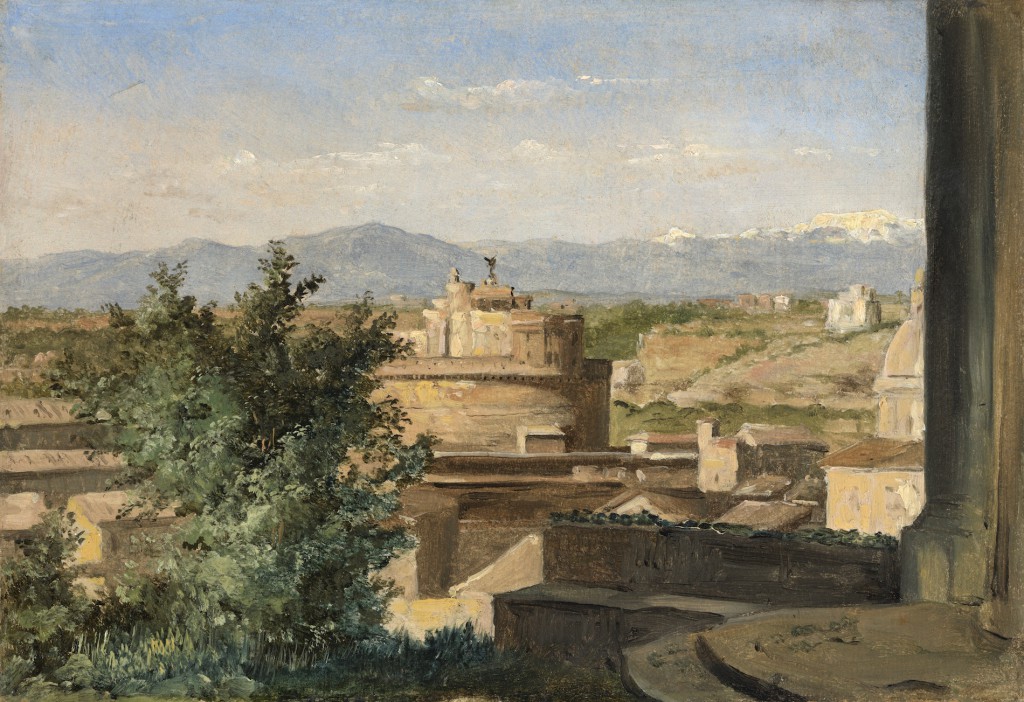Raymond Auguste Quinsac Monvoisin (Bordeaux 1790 - 1870 Boulogne-sur-Mer)
View of Rome from the Janiculum Hill, with Castel Sant'Angelo and the Church of San Giovanni dei Fiorentini, c.1821-5
Oil on paper, laid down on cardboard, 14.5 x 20.6 cm
SOLD / VERKAUFT
Raymond Auguste Quinsac Monvoisin was widely feted in his own lifetime by an international public but since then his work has lapsed into obscurity and is little known to collectors in Europe today. He studied at the Ecole des Beaux-Arts in Bordeaux and moved to Paris to continue his training in the studio of Pierre-Narcisse Guérin. He won a Prix de Rome bursary in 1820 and this enabled him to continue his studies in Rome at the Académie de France.[1] He was at the start of a promising career when he was involved in a dispute over a public commission he had been awarded. He rejected the demands of his patron and stubbornly refused to modify the design he had submitted. This was seen as an arrogant display of bad behaviour and it was to overshadow the rest of his career in France. Museum officialdom, obedient to king Louis-Philippe, mercilessly pursued him for his show of insubordination. He fell from grace and patronage dried up. He decided to emigrate to South America and set off for Buenos Aires in 1840. He was to live and work in Argentina, Brazil, Chile and Peru, acquiring an array of high-ranking patrons - dignitaries like Dom Pedro II, Emperor of Brazil; Empress Teresa Cristina Maria; Manuel Bulnes Prieto, President of Peru; and Juan Manuel de Rosas, President of Argentina. The Chilean government appointed Monvoisin director of the Academy of Arts in Santiago. Chilean society turned out to be particularly receptive to European cultural influences - especially from France - and his portraits were to have a major impact on local developments in fashion and taste. Monvoisin was appointed a knight of the Legion of Merit of Chile in 1857. He returned to France in 1858.
Monvoisin executed the present study on his stay in Rome at some point between 1821 and 1825. He has chosen a viewpoint on the Janiculum Hill. The confidence that he displays in the handling of this fluid, highly evocative plein-air study evidences the powerful creative influence of the French Academy in Rome. Two important Prix de Rome winners of Monvoisin's generation were Jean-Baptiste-Camille Corot and Achille-Etna Michallon, both of whom were tireless exponents of plein-air painting. Pierre-Henri de Valenciennes, also a Prix de Rome scholar at the Villa Medici, had already laid out the practical and theoretical foundations for plein-air painting and the direct study of nature some thirty years earlier (Fig. 1). In 1799 he had published a seminal work on landscape painting titled Élémens de Perspective Pratique, à l'usage des Artistes, suivis De Réflexions et Conseils à un Élève sur la Peinture, et particulièrement sur le genre du Paysage.
This small-format oil study has the spontaneity of a rapidly recorded segment of reality - recorded with almost photographic immediacy. However the choice of viewpoint is in no way random and the motif is clearly staged. Interestingly, a similar approach characterizes the plein-air oil sketches Corot executed on his first visit to Rome in the years 1825 to 1827.
Monvoisin uses the large bush in the left foreground and the shadowy vertical of stonework at the right as framing devices, much like elements of a stage set, and places them in sharp contrast to the brightness of the architecture in the middle ground. The eye is led from the dome of San Giovanni dei Fiorentini towards Castel Sant'Angelo at the centre of the image. Distant slopes and beyond them, a panorama of the Sabine Hills veiled in a diffuse bluish haze form a backdrop.

Fig. 1 Pierre-Henri de Valenciennes, Le Palais de Neni, c. 1780, Musée du Louvre
---
[1] The Academy had been housed in the Villa Medici since 1803.
